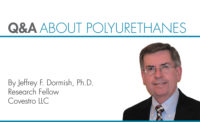Q&A About Polyurethanes
What types of chemical structures could be built into a polyurethane adhesive to optimize heat resistance?
Formulation recommendations can be made to address each aspect of thermal stability.

The question you have posed can be approached from two viewpoints. One addresses the temperature at which a polymer softens to the extent that it is no longer able to meet the elevated temperature requirements of the application. The other focuses on the thermal stability of the chemical structures in the polyurethane polymer backbone. Formulation recommendations can be made to address each aspect of thermal stability. Polyurethane polymers are frequently composed of “hard blocks” from the reaction of isocyanates with low-molecular-weight glycols or diamines, and “soft blocks” based on di- or tri-functional polyether or polyester polyols. These hard blocks associate through hydrogen bonding and form pseudo, or virtual, crosslinks in the polyurethane network. Once the polyurethane reaches a temperature where these hard block domains soften, the polymer shows thermoplastic behavior. This softening reduces the modulus of the polymer, and the adhesive will not have the strength it demonstrated at room temperature.
The high temperature performance can be improved by increasing the content of the hard block in the polymer or by increasing the strength of the hydrogen bonded network. Early solvent-based polyurethane adhesives consisted of a polyester polyol reacted with a polyisocyanate, such as toluene diisocyanate or diphenylmethane diisocyanate (MDI). These products had limited thermal resistance and needed to be crosslinked with a trifunctional polyisocyanate to produce a finished adhesive with the required high temperature performance. These two-component systems achieved improved heat resistance but showed the limited pot life drawback inherent with any reactive adhesive. The high temperature properties of these polyester polyurethane adhesives were completely changed when a significant portion of butane or hexane diol was introduced into the formula of the polymer. An increased rate of bond strength development occurred and the heat strength increased to such a degree that this improved polymer could meet the needs of the application without the use of a crosslinker.
The reaction of polyamines with polyisocyanates produces polyureas that also associate to form hard blocks. Polyureas are more polar than polyurethane groups, which lead to the formation of stronger hydrogen bonds. This produces polymers with an even higher level of heat resistance and polymer properties.
Adding multifunctional raw materials into a two-component adhesive formulation will increase the crosslink density of the polymer. This will lead to an improvement in elevated temperature performance. The higher functionality can be introduced via the polyisocyanate or polyol component of the polymer. Typical polyisocyanates could be polymeric MDI with a functionality of 2.3-3 or an aliphatic polyisocyanate based on the trimer of hexamethylene diisocyanate. Functionality can be increased in the polyol component by using either low- (~ 260) or high- (6,000) molecular-weight tri- or tetra-functional polyether polyols. Care must be taken to limit the overall crosslink density to prevent the formation of a hard rigid polymer that may not have the required flexibility to distribute stresses that will be placed on a bonded assembly.
Improvements in overall adhesive performance can also be achieved by using an isocyanate/hydroxyl ratio greater than one. The excess isocyanate groups can having a priming effect or can react with urethane linkages in the polymer to make allophanate structures that increase the overall crosslink density. The polyisocyanate could also react with water in the environment to produce ureas.
The topic of the thermal stability of the various chemical structures that may be present in a polyurethane polymer (isocyanurate, biuret, allophanate, urea and urethane) will be addressed in a later column.
Any views or opinions expressed in this column are those of the author and do not represent those of ASI, its staff, Editorial Advisory Board or BNP Media.
Looking for a reprint of this article?
From high-res PDFs to custom plaques, order your copy today!






